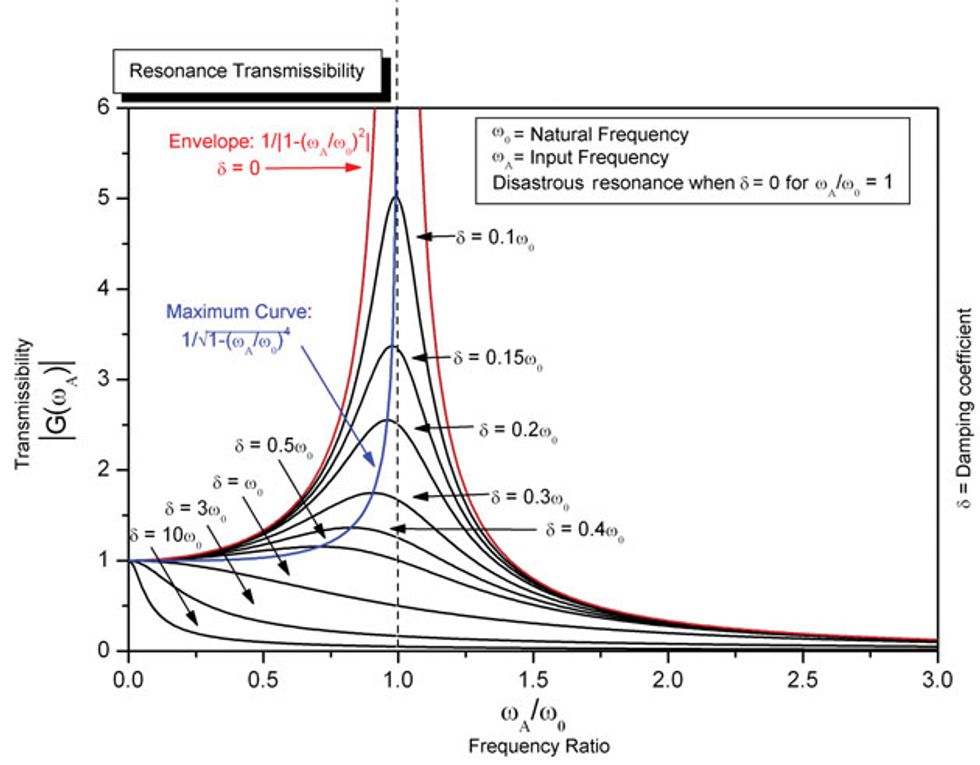Image in public domain
Last month, we took a quick look at two inventions that purport to capitalize on the physics behind the term resonance in a column called “The Perils of Tech Speak.” Before we get into the science of resonance, let’s summarize what these systems were designed to do for us.
One system uses tuning forks machined into the core of a chambered body to “recirculate the vibrations back into the strings, greatly increasing the resonance quality and note sustaining ability.” The second invention uses “resonant softwood embedded between harder tonewoods with a series of aluminum tubes passing through the core from the bridge to allow the string vibrations to achieve clear passage through the body mass.”
It’s important to note that these two systems are not describing acoustic instruments. On an electric bass or guitar, the process of converting a string’s movement to an audible tone is dominated by what happens above the instrument’s pickup.
Drilling down. Resonance describes what happens when a vibrating system or external force drives another system to oscillate by transferring energy between the two. This transfer works best if the resonant frequencies of the two systems are identical or multiples of each other. Fig. 1 is all about resonance, and although it contains way more information than we actually need to understand the principles, it’s just too beautiful not to share. Everything has a resonant frequency, a dampening factor, and a quality factor—the Q—that describes the spectral line width or sharpness of a resonant peak, as shown in the diagram.
Case studies. Here’s a simple example of resonance at work: Whenever we pluck a string, it starts to vibrate at its resonant frequency (and higher multiples or upper harmonics). So by plucking a low E while fretting another E on a higher string, it happens that the vibration of the body and neck triggers the higher E to resonate. Dampen the low E and the fretted one still rings because of the transfer of vibrational energy via resonance between the two.
At least in theory, it should be possible to measure the sustain of the initial note and observe how it differs depending on whether or not the second note is fretted. Fretting the second E will reduce the sustain of the plucked string because the second E sucks up the vibrations, while fretting an F won’t have the same effect since it doesn’t have the same resonant frequency.
Here’s what Fig. 1 tells us about the quotient of the input frequency (low E) and natural or secondary frequency (fretted note): There is a maximum of transmitted energy between the two when their frequencies are identical or at least very close to each other. Resonance isn’t a broad frequency phenomenon—it’s limited to small frequency bands.
Here’s a second example: Let’s say we have a loose part on the bridge or a spring-loaded whammy that starts to vibrate or even rattle once a certain note is plucked. This is resonance, and once again it’s going to take energy away from the string, stealing it from somewhere in the string’s tonal spectrum. And here, stealing means that these frequencies are missing from the final output signal. Due to the sharpness of the resonance peak, each and every resonating part other than our strings will to some degree cut sharp dents into the remaining spectrum. Why would you want to maximize this?
What we’ve learned. Returning to the systems we summarized a moment ago, both would immediately eat up energy from the string’s signal once we’d hit the few frequencies they are tuned to. All physical instruments will have some inevitable resonances and dampening, which is the main reason why there are so many instruments that sound different. But for a solidbody electric, the whole notion of increasing sustain with resonant tonewoods or letting a string send its vibrations into the body to resonate before returning to the string is pretty much nonsense.
You’d think if one of the resonance-enhancing systems worked as promised, it would have generated at least some reaction from owners by now. It hasn’t, which gives us an idea of a body’s tonal influence on a solid electric instrument ... obviously not that much.


















